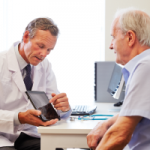“We’re seeking out more versatile ways—instead of traditional cortisone shots—to help maintain joints with a better local delivery system,” Dr. Ranawat says.
A pilot study at HSS suggests that PRP may play a role in improving clinical outcomes in patients with early onset osteoarthritis after both six months and one year.1 Further, in a systematic review of the basic science evidence for the use of PRP conducted by HSS researchers, the authors concluded that PRP has several potential effects on cartilage repair and osteoarthritis.2
Other New Treatments
HSS is at the forefront of using other new and innovative arthritis treatments. For example, Dr. Fields is prescribing the self-injected biologic medication secukinumab (Cosentyx) for psoriatic arthritis. “This medication was originally approved by the FDA for psoriasis without arthritis, but ongoing studies proved that it also works for psoriatic arthritis,” he says. “Rheumatologists still don’t have as many medications to treat psoriatic arthritis as we need, because different patients respond differently to medications, so it is great to have another medication in our armamentarium.”
Secukinumab can dramatically reduce patients’ number of swollen and tender joints or can even help them reach complete remission without any stiffness, swelling or tenderness, Dr. Fields continues.
For gout, lesinurad (Zurampic) is the most recently FDA-approved medication—although it’s not available to prescribe yet. “This medication can help gout patients who already take a medication—such as allopurinol or febuxostat (Uloric)—and still have been unable to get their uric acid less than 6, to be more likely to get their uric acid down low enough. After a person with gout gets their uric acid below 6 and keeps it there for a period of time, they are extremely likely to not have further gout attacks.”
Researchers are also evaluating running surfaces. In general, athletes prefer softer tracks more than traditional pavements, because they tend to experience less pain in their ankles and hips. Another philosophy under investigation is the merits of barefoot running for younger individuals ages 15 to 20. Advances in braces and footwear can help decrease load.
Proper nutrition is also key for avid athletes. Dr. Russell recommends athletes with injuries get their vitamin D levels checked, because a normal level helps maintain muscle strength.
Final Thoughts
“The key for athletes who have pain is to get evaluated, and not work through the pain,” Dr. Russell concludes. “By understanding why they have pain, patients can make educated decisions regarding which activities to continue and which courses of treatment to take.”

